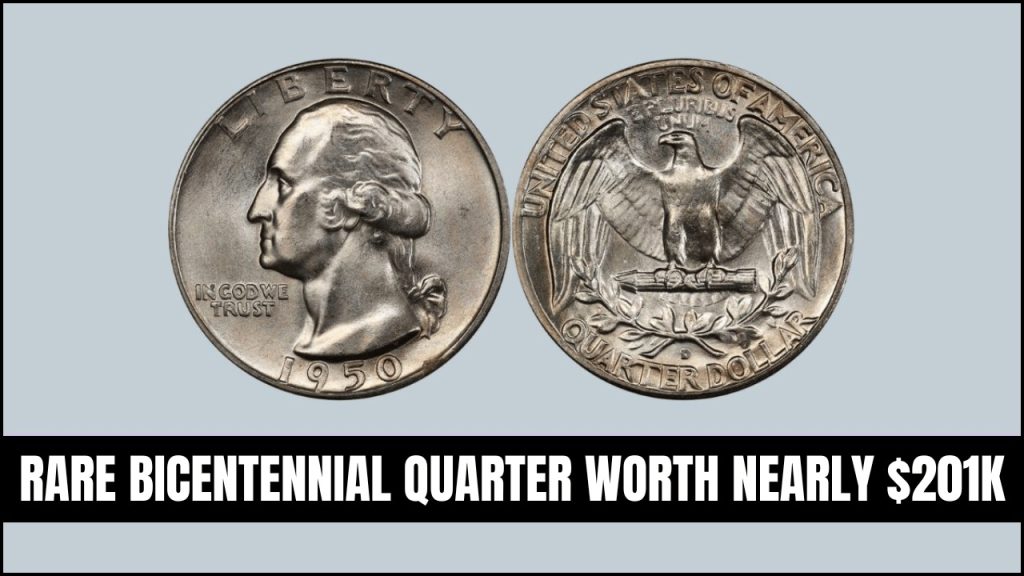
Numismatics combines historical appreciation, artistic admiration, and the excitement of discovering unexpected valuables. While most quarters only hold their face value, several exceptional specimens can command astonishing prices at auction.
Certain coins possess distinctive flaws, limited production runs, or special metal compositions that make them highly coveted among collectors. Below, we explore seven remarkable quarters that have commanded impressive sums and might potentially be concealed in your personal collection.
(Read Also – Rare Bicentennial Quarter Worth Nearly $11 Million)
Bicentennial Quarter
Perhaps the most surprising valuable quarter is a 1976 Bicentennial specimen that sold for an incredible $201,000. The United States Mint created these quarters to commemorate America’s 200th birthday, but the majority were produced using standard copper-nickel composition. However, a special variant containing 40% silver was manufactured specifically for collector editions.
What elevates this particular quarter’s value isn’t solely its silver content but also its immaculate condition and professional grading. Coins authenticated by recognized grading services as nearly flawless examples can achieve remarkable prices. This sale demonstrates that even relatively contemporary quarters can be worth substantial sums when multiple favorable factors combine.
(Read Also – 5 Rare Bicentennial Quarters Worth $2.5 Million)
1932-S Washington Quarter
The 1932-S Washington Quarter remains one of the most desirable coins in the Washington Quarter series. With a limited production of only 408,000 pieces, it has the smallest mintage of any standard-issue Washington Quarter, making it essential for serious collectors.
The “S” mintmark indicates it was produced in San Francisco, enhancing its appeal. Well-preserved examples have commanded over $25,000, and their value continues to appreciate. Should you discover one in your collection, particularly in excellent condition, you may possess a genuine numismatic treasure.
1943 Copper Quarter
During World War II, the United States Mint modified coin compositions to conserve metals for wartime production. In 1943, quarters were intended to be struck in silver, but a handful were mistakenly produced using copper, creating an extraordinary rarity.
These copper quarters represent one of the most significant error coins in American numismatic history. To identify a potential rare specimen, check if your 1943 quarter adheres to a magnet—if it does, it’s made of silver, but if it doesn’t, you might possess a rare copper version. In exceptional condition, these coins can sell for more than $25,000.
1950-D/S Overmintmark Quarter
Minting mistakes often make coins highly desirable, and the 1950-D/S Overmintmark Quarter exemplifies this phenomenon. In this instance, the Denver (“D”) mintmark was erroneously stamped over a San Francisco (“S”) mintmark. This manufacturing error creates a unique and valuable specimen for collectors.
A high-grade 1950-D/S quarter can readily achieve more than $25,000 at auction. These overmintmark errors illustrate how coin production occasionally included imperfections, resulting in collectible mistakes that increase in value with time.
1964-D Doubled Die Quarter
The 1964-D Doubled Die Reverse Quarter represents another fascinating numismatic example. This quarter displays a doubling effect on its reverse side, most noticeably in the phrase “E PLURIBUS UNUM.” The doubling resulted from a misaligned die, creating a visible shift in the design elements.
Collectors eagerly seek these doubled die quarters due to their distinctive visual characteristics. When found in superior condition, this quarter can command over $25,000. The pronounced doubling effect makes it a treasured acquisition for those who appreciate minting errors.
1970-S Small Date Quarter
The 1970-S Small Date Quarter is a scarce variant featuring slightly reduced date numerals compared to standard 1970 quarters. While this distinction may appear minor, it significantly impacts the coin’s market value.
Collectors willingly pay premium prices for well-preserved examples of this quarter. High-quality specimens of the 1970-S Small Date Quarter have reached values exceeding $25,000. This coin reminds us that even subtle design variations can create considerable worth in numismatic circles.
1983-P Washington Quarter
The 1983-P Washington Quarter represents a modern rarity with surprising value. The primary reason for its elevated worth is that few were preserved in mint condition. Unlike other quarters that were frequently collected, most 1983-P quarters circulated heavily, making uncirculated examples scarce.
A pristine 1983-P quarter can fetch prices over $25,000, demonstrating that even more recent coins can be highly valuable if they’re well-preserved and difficult to locate.
It’s remarkable how a simple 25-cent piece can potentially be worth thousands of dollars. Whether through minting errors, limited production runs, or special compositions, these rare quarters highlight the unexpected treasures that might reside in your pocket change or coin collection. If you’re fortunate enough to encounter one of these special pieces, you might possess a small fortune.
Common Questions
How can I determine if my quarter has significant value?
Examine the date, mintmark, physical condition, and look for any unusual characteristics or errors.
What venues are appropriate for selling valuable quarters?
You can sell them through coin dealers, specialty auctions, or reputable online marketplaces.
Which U.S. quarter is considered the most uncommon?
The 1932-S Washington Quarter is generally recognized as one of the scarcest key dates.
Why do manufacturing errors increase a coin’s value?
Errors represent unique anomalies in production, making them rare and highly collectible.
What’s the best way to preserve valuable quarters?
Store them in protective holders or cases and avoid handling them directly to prevent damage.